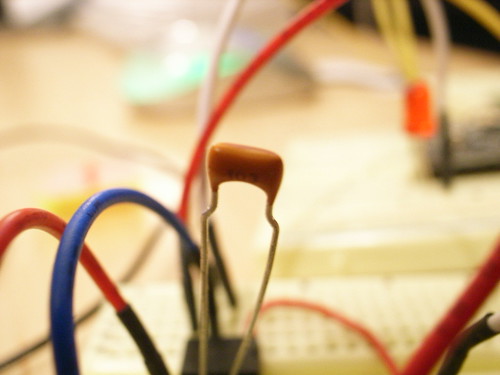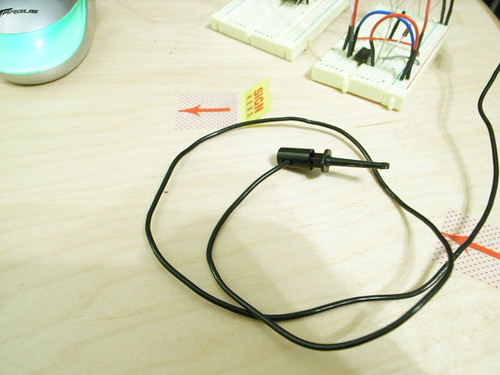
103, .01uF, light contact trigger
I need a touch sensor for a couple of projects, and the Qprox QT113 seems to be the way to go, particularly for interfacing with an Atmel processor. It’s easy to work with, and hooks-up with only a bare minimum of extra stuff. All you need is a resistor and capacitor and a bit of wire or trace to compose the sensor.
Tom Igoe documents most of the details here.
There’s one wrinkle in my project, and that’s figuring out what value I should use for the capacitor — which is basically what controls the sensor’s, you know..sensitivity. So, I tried two values, .01uF and .1uF, to find out what the thing means by “touch.” (I’m looking at something that is more ambient than a full-on, bone-jarring style touch — something closer to “nearby”.)
Rough experiment. I used about a 24″ bit of test lead hooked up to the sensor pin of a QT113. I coiled it into a very loose 3″ diameter loop, about two wraps. Nothing precise here. I placed it on the surface of a 1″ thick wooden desk surface.
With the .01uF capacitor, I basically had to make physical contact, albeit light, with my open palm over the loop to get it to trigger. A single finger placed on a bit of loop lightly, wouldn’t trigger it, but if I put two or three fingers, it would trigger.
With the .1uF capacitor, I could trigger the sensor by hovering my palm a half inch or more above the coil. I could also trigger it if I placed my palm underneath the desk surface where the sensor coil was sitting.
So, 104/.1uF will give more sensitivity to the degree of a half or so inch of air between a loop sensor, while 103/.01uF requires light physical contact with the sensor.
This is what the specification sheet means by “higher values of Cs increase gain”
Short note on the QT113 and QT118 — these parts each have a varient, the “H” part — QT113H and QT118H. The variant basically inverts the logic level of the output, so it goes high (logic 1, or VCC) when it’s triggered. Other useful notes about these devices is that they can be configured to have a sustained output when triggered, or to stay on for 10 seconds or 60 seconds. The QT118 also offers a “toggle” mode so that each trigger flips the state, and a pulse-mode output.
